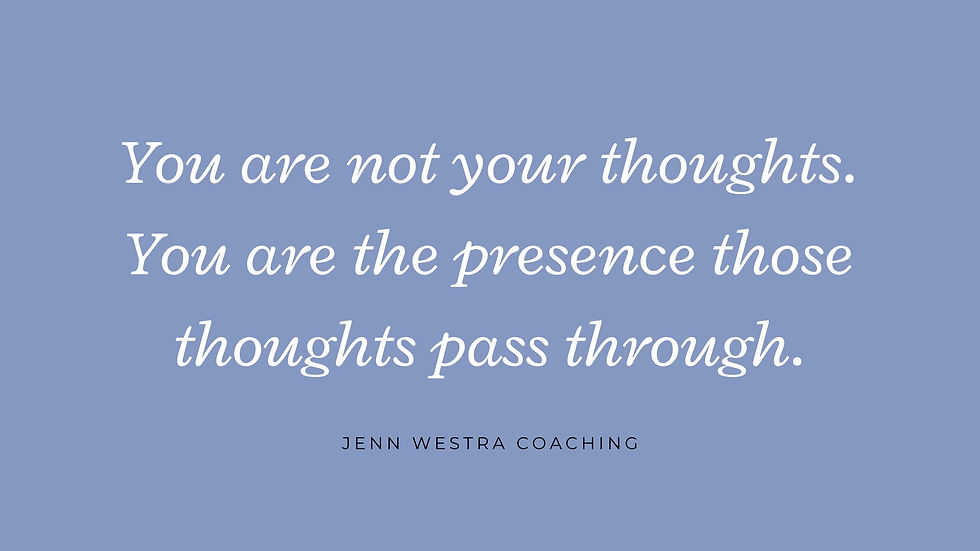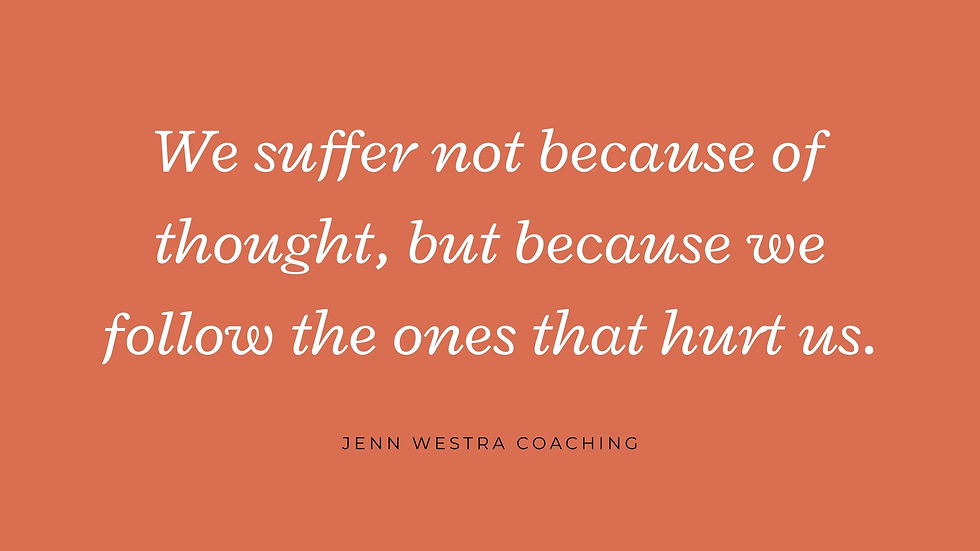Bouncing Back: Building a Healthier Relationship with Your Thinking
- Jennifer Westra
- Oct 30
- 4 min read

Getting Caught in Thought Is Human
We all do it. One moment, we’re fine—clear-headed, present. The next, we’re suddenly deep in a swirl of overthinking, analyzing, rehashing, or worrying. The mind kicks up a flurry of thoughts, and before we know it, we’re tangled in the middle of it, caught in a feeling that seems real and urgent.
This is part of being human. Our minds are meaning-making machines, constantly interpreting, predicting, protecting. But the goal isn’t to never get caught in thought. That’s impossible. The real freedom comes from how easily we can bounce out of it when we realize what’s happening.
How Inspiration Gets Hijacked
Not long ago, I noticed a very particular version of this.
I had a beautiful thought—an idea for a new project. It felt alive. Exciting. Full of creative possibility.
But within seconds, I could feel the familiar habit of insecurity creeping in. Thoughts like “What if it doesn’t work?” or “Who do you think you are?” slid in quietly, almost unnoticeably. Before I knew it, the spark was gone. The original idea felt further away, overtaken by doubt.
And then, just as suddenly, I saw what had happened. I caught it. I realized I had drifted away from the original thought—away from inspiration and into old patterns of fear.
And that recognition gave me something precious: the ability to go back.
Back to the spark. Back to the creativity. Back to the original idea, this time without the noise.
That’s the power of awareness. The power of being able to redirect yourself when you see you’ve gone off course.
The Power of Perspective
What you want to cultivate is a relationship with your thinking where you can bounce back—where you don’t stay stuck in a mental storm longer than you have to. It’s not about avoiding difficult thoughts or feelings. It’s about realizing what they are when they show up.
Sometimes you’ll get totally wrapped up in your thinking. You’ll feel it deeply. You’ll analyze it, try to figure it out, and run through all the possible meanings.
That’s okay. That’s normal.
But eventually—because of the wisdom built into your system—you’ll notice:
“Oh. I’m doing that thing again.”
And in that noticing, you get a little bit of distance. You remember that it’s just thought. It’s not the truth. It’s not permanent. It’s just what your mind is doing right now.
And with that realization, you bounce back.
The thinking might still be there, but it doesn’t grip you in the same way.You’ve found your footing again.
Resilience Is in the Rebound
Many people think resilience means never getting knocked down. But true resilience is about how you recover. It’s your bounce-back rate.
And in the realm of thought, resilience looks like remembering again and again:
“This isn’t me. This is just a moment of thought.”
It looks like not blaming yourself for getting caught in it.
It looks like having compassion for your humanness.
It looks like a return to clarity—sometimes quickly, sometimes slowly, but always eventually.
Over time, your relationship with your mind changes. You stop needing to fix every negative thought. You stop fearing every low feeling. You start to see them as temporary weather patterns, not personal verdicts.
And because of that, you suffer less. You move through life more lightly. You live with more ease.
It’s Not About Control—It’s About Understanding
Trying to control your thinking is a losing game. Thoughts come and go. You don’t choose most of them. What you can do is understand the nature of thought.
You can see that thought creates your feeling.
You can see that your mind is constantly shifting, and that no state is final.
You can see that the moment you realize you’re caught in thought, you’re already a little freer.
This understanding softens your grip on needing things to be different.
It makes room for grace.
And from that grace comes space for insight, creativity, humor, and relief.
It’s All Just Human
One of the kindest things you can do for yourself is to stop taking your thought spirals personally. Everyone gets caught. Everyone loops. Everyone creates elaborate inner narratives at times that feel real and consuming.
It’s just human.
The difference comes in whether you believe the story—or whether you see it as a story. Whether you dwell or bounce. Whether you condemn yourself or laugh and come home to yourself.
And whether you return to the original beautiful thought… before fear got ahold of it.
Practice the Bounce
You can start small. The next time you notice your mood shift or your mind racing, pause. See if you can recognize: “Ah, I’m caught in something.”
Then remind yourself: “It’s just thought. It’ll pass. I don’t need to solve it right now.”
You might still feel stirred up for a bit. That’s okay.
You’re not trying to force peace.
You’re just remembering your deeper truth underneath the noise.
And then, before you know it, you bounce back.




Comments